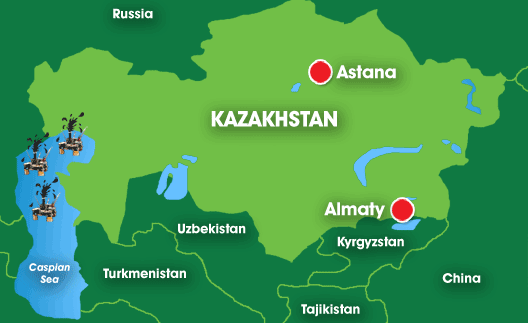Map of Astana- Kazakhstan

Astana is the capital of Kazakhstan. It is located on the Ishim River in the north portion of Kazakhstan, within the Akmola Region, though administrated separately from the region as a city with special status. The 2014 census reported a population of 835,153 within the city limits, making it the second largest city in Kazakhstan.
Founded in 1830 as a settlement of Akmoly, it served as a defensive fortification for the Siberian Cossacks. In 1832 the settlement was granted a town status and renamed Akmolinsk. On March 20, 1961 the city was renamed Tselinograd to mark the city’s evolution as a cultural and administrative center of the Virgin Lands Campaign. In 1992 it was renamed Akmola (Kazakh: Ақмола), the modified original name meaning “a white grave”. On December 10, 1997 Akmola replaced Almaty as the capital of Kazakhstan. On May 6, 1998 it was renamed Astana, which means “the capital” in Kazakh.
Today’s Astana is a planned city, like Brasília in Brazil, Canberra in Australia, and Washington, D.C. in the United States. The city took its current form after the independence of Kazakhstan in 1991, under President Nazarbayev. The master plan of Astana was designed by Japanese architect Kisho Kurokawa.
As the seat of the Government of Kazakhstan, Astana is the site of the Parliament House, the Supreme Court, the Ak Orda Presidential Palace and numerous government departments and agencies. It is home to many futuristic buildings, hotels and skyscrapers. Astana also has extensive healthcare, sports and education systems.
Population: 860,368 (2014)
Language: Kazakh, spoken by over 52{dd18ac34bc97cfcd435c38e45670fcb37b355e8df16dffc9cb107768e32cef97} of the population, is the state language
Currency
The Tenge (KZT)

Geography
Astana is located in central Kazakhstan on the Ishim River in a very flat, semi-arid steppe region which covers most of the country’s territory. It is at 51° 10′ north latitude and 71° 26′ east longitude, and the 50th parallel north passes through the southern parts of the city. The city encompasses 722.0 square kilometres (278.8 sq mi). The elevation of Astana is 347 m (1,138 ft) above sea level. Astana is in a spacious steppe landscape, in the transitional area between the north of Kazakhstan and the extremely thinly settled national centre, because of the Ishim River. The older boroughs lie north of the river, whilst the new boroughs are located south of the Ishim.
Climate
Astana is the second coldest capital city in the world after Ulaanbaatar, Mongolia, a position formerly held by Canada’s capital, Ottawa, until Astana attained capital city status in 1997. Astana has an extreme continental climate with warm summers (featuring occasional brief rain showers) and long, very cold, dry winters. Summer temperatures occasionally reach +35 °C (95 °F) while −30 to −35 °C (−22 to −31 °F) is not unusual between mid-December and early March. Typically, the city’s river is frozen over between the second week of November and the beginning of April. Astana has a well-deserved reputation among Kazakhs for its frequent high winds, the effects of which are felt particularly strongly on the fast-developing but relatively exposed Left Bank area of the city.
Overall, Astana has a humid continental climate (Köppen climate classification Dfb), The average annual temperature in Astana is +3.5 °C (38.3 °F). January is the coldest month with an average temperature of −14.2 °C (6.4 °F). July is the hottest month with an average temperature of +20.7 °C (69.3 °F).
History
The settlement of Akmoly, also known as Akmolinsky prikaz, was established on the Ishim River in 1830 as the seat of an okrug by a unit of the Siberian Cossacks headed by Fyodor Shubin. The name was possibly given after a local landmark—Akmola literally means “a white grave” in Kazakh—although this theory is not universally accepted. In 1832, the settlement was granted town status and named Akmolinsk. The fairly advantageous position of the town was clear as early as 1863 in an abstract from the Geographic and Statistical Dictionary of the Russian Empire. It describes how picket roads and lines connected this geographic centre to Kargaly in the East, Aktau fort in the South and through Atbasar to Kokchetav in the West. In 1838, at the height of the great national and liberation movement headed by Kenesary Khan, Akmolinsk fortress was burned. After the repression of the liberation movement, the fortress was rebuilt. On 16 July 1863, Akmolinsk was officially declared an uyezd town. During the rapid development of the Russian capitalist market, the huge Saryarka areas were actively exploited by the colonial administration. To draft Regulation governing the Kazakh steppe the Government of the Russian Empire formed Steppe Commission in 1865. On 21 October 1868, Tsar Alexander II signed a draft Regulation on governing Turgay, Ural, Akmolinsk and Semipalatinsk Oblasts. In 1869, Akmolinsk external district and department were cancelled, and Akmolinsk became the centre of the newly established Akmolinsk Oblast. In 1879, Major General Dubelt proposed to build a railway between Tyumen and Akmolinsk to the Ministry of Communications of Russia. In the course of the first 30 years of its existence, the population of Akmola numbered a trifle more than 2,000 people. However, over the next 30 years the city’s population increased by three times according to volosts and settlements of the Akmolinsk Oblast. In 1893, Akmolinsk was an uyezd with a 6,428 strong population, 3 churches, 5 schools and colleges and 3 factories.
During World War II, Akmolinsk served as a route for the transport of engineering tools and equipment from evacuated plants in the Ukrainian SSR, Byelorussian SSR, and Russian SFSR located in the oblasts of the Kazakh SSR. Local industries were appointed to respond to war needs, assisting the country to provide the battle and home fronts with all materials needed. In the post-war years, Akmolinsk became a beacon of economic revival in the west of the Soviet Union ruined by the war. Additionally, many Russian-Germans were resettled here after being deported under Joseph Stalin rule.
In the 1950s, Northern Kazakh SSR oblasts became a territory of the Virgin Lands Campaign led by Nikita Khrushchev, in order to turn the region into a second grain producer for the Soviet Union. In December 1960, Central Committee made a resolution to create the Tselinniy Krai, which comprised five regions of the Northern Kazakh SSR oblasts. Akmolinsk Oblast was ceased to exist as a separate administrative entity. Its districts were directly subordinated to the new krai administration, and Akmolinsk became the krai capital, as well as the administrative seat of the new Virgin Lands economic region. On 14 March 1961, Khrushchev proposed to rename the city to name corresponding to its role in the Virgin Lands Campaign. On 20 March 1961, the Supreme Soviet of the Kazakh SSR renamed Akmolinsk to Tselinograd. On 24 April 1961, the region was reconstituted as Tselinograd Oblast. In the 1960s, Tselinograd was completely transformed. In 1963, work on the first three new high-rise housing districts began. In addition, the city received a number of new monumental public buildings, including the Virgin Lands Palace, a Palace of Youth, a House of Soviets, a new airport, and several sports venues. In 1971, the Tselinniy Krai was abolished and Tselinograd became the centre of the oblast.
After the dissolution of the Soviet Union and the consequent independence of Kazakhstan, the city’s original form was restored in the modified form Akmola. On 6 July 1994, the Supreme Council of Kazakhstan accepted the decree “On the transfer of the capital of Kazakhstan”. After the capital of Kazakhstan was moved to Akmola on 10 December 1997, the city was consequently renamed Astana in 1998. On 10 June 1998, Astana presented as the capital internationally. On 16 July 1999, Astana was awarded the medal and title of the City of Peace by UNESCO.
Transport
Public transport in Astana consists of buses and share taxis. Over 720,000 people use public transport daily. There are over 40 bus lines served by more than 1000 vehicles, with over 3000 people working in the public transport sector. Just like buses, marshrutkas have their own predefined routes and work on a shared basis. There are nine marshrutka routes in total. In 2011, Akimat of Astana established a company to implement a series of changes and programmes in the metropolis known as the “New transport system of Astana”. As the part of these programmes, Bus rapid transit (BRT) lines are expected to start operating in Astana in 2016. Astana Light Metro is a proposed light rail system. Astana also has air taxi service and a modern bicycle-sharing system, Astana-bike.
Astana International Airport (IATA: TSE, ICAO: UACC), located 17 kilometres (11 mi) south-east of the city centre, is the main gateway for the city’s domestic and international civilian air traffic. It is the second busiest airport in Kazakhstan, with 2,960,181 passengers passing through it in 2014. The airport hosts 13 airlines operating regular passenger flights inside the country and internationally. Air Astana maintains its second largest hub at the airport. An expected 50{dd18ac34bc97cfcd435c38e45670fcb37b355e8df16dffc9cb107768e32cef97} increase in passenger traffic by 2017 has spurred construction of a new terminal with an area of about 40,000 sq. m.
Astana railway station is the city’s main railway station and serves approximately 7,000 people each day. A new rail station is currently being built with a proposed customer capacity of 12,000. Tulpar Talgo is a daily express train to Almaty. Short-term plans include construction of a new railway station in the industrial district; in the vicinity of CHPP-3 a new terminal will be erected for freight cars.
Astana is located in the centre of the country, serving as a well-positioned transport node for rail and automotive networks. M-36 Chelyabinsk-Almaty and A-343 Astana-Petropavlovsk highways are routed through the city. The strategic geographical positioning of Astana allows the city to serve as a transport and reload centre for cargoes formed at adjacent stations in the area.










